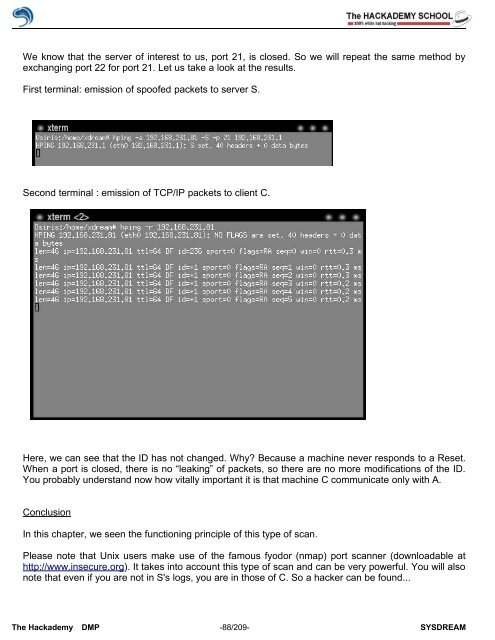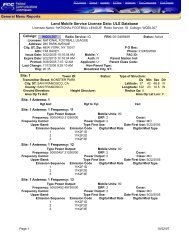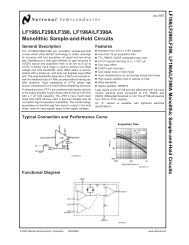- Page 1 and 2:
Hack security “pro”
- Page 3 and 4:
Authors For their contribution to t
- Page 5 and 6:
Chapter IV: Web Vulnerabilities....
- Page 7 and 8:
INTRODUCTION TO TCP/IP NETWORKS Net
- Page 9 and 10:
In case of reception, each layer wi
- Page 11 and 12:
ARP heading: The Hackademy DMP -11/
- Page 13 and 14:
Version: 4 bits. The version field
- Page 15 and 16:
TCP header: Source Port: 16 bits. T
- Page 17 and 18:
TCP/UDP Port Notions: Multiplexing/
- Page 19 and 20:
Start the MS-DOS control interface
- Page 21 and 22:
CHAPTER I INFORMATION ACQUISITION T
- Page 23 and 24:
expires: 2005-10-28 11:28:29 create
- Page 25 and 26:
In the answer field you will find:
- Page 27 and 28:
nmap -sP 192.168.124.0/24 Starting
- Page 29 and 30:
C) Fingerprinting the system The nm
- Page 31 and 32:
It is also possible to specify seve
- Page 33 and 34:
SMTP : Simple Mail Transfer Protoco
- Page 35 and 36:
SNMP : Simple Network Management Pr
- Page 37 and 38: Here is a scan report obtained with
- Page 39 and 40: # nmap 3.50 scan initiated Wed May
- Page 41 and 42: CHAPTER II CLIENT VULNERABILITIES T
- Page 43 and 44: File viruses: These viruses attack
- Page 45 and 46: Retroviruses are a bit more aggress
- Page 47 and 48: However, do check in the start file
- Page 49 and 50: Creating a hidden gateway : But the
- Page 51 and 52: infallible. It consists in associat
- Page 53 and 54: DOS commands if conditional pluggin
- Page 55 and 56: Each one of these zones can be conf
- Page 57 and 58: The javascript code destined to dow
- Page 59 and 60: The wizard will ask you the locatio
- Page 61 and 62: CHAPTER III NETWORKS VULNERABILITIE
- Page 63 and 64: Here, the connection between the ro
- Page 65 and 66: Using the "Follow TCP Stream" optio
- Page 67 and 68: You have just created a new filter.
- Page 69 and 70: This handshake takes place as follo
- Page 71 and 72: Third step Illustration 3: ACK To c
- Page 73 and 74: The methodology of this type of att
- Page 75 and 76: The case of the UDP protocol Unlike
- Page 77 and 78: nc -l -v -n -p 887 Injection of com
- Page 79 and 80: Let's try to connect again from mac
- Page 81 and 82: We can see that Ethereal has seen i
- Page 83 and 84: Conclusion The covert channel princ
- Page 85 and 86: It is the IP protocol that is going
- Page 87: We will simultaneously launch the p
- Page 91 and 92: Let us now display the contents of
- Page 93 and 94: B) DNS hijacking The DNS protocol i
- Page 95 and 96: ssh2 protection The server's public
- Page 97 and 98: B) SSL The SSL protocol functions w
- Page 99 and 100: Recent viruses use the resources of
- Page 101 and 102: 1.Site Mapping The first thing a ha
- Page 103 and 104: Scan_web.php Scan_web.php is a PHP
- Page 105 and 106: The phpinfo() function gives the ha
- Page 107 and 108: ack to an error message */ if ($ok
- Page 109 and 110: System() Function The System() func
- Page 111 and 112: Uploading via PHP Quite often, one
- Page 113 and 114: inc.php file page1.php file By ty
- Page 115 and 116: There are other functions of the sa
- Page 117 and 118: i=0; j=0; while (data[i] != '=') {
- Page 119 and 120: system("/usr/bin/sendmail -t test@t
- Page 121 and 122: In all cases, it is also important
- Page 123 and 124: It is therefore vital to understand
- Page 125 and 126: The error means that the SQL reques
- Page 127 and 128: } else{ } $query = "UPDATE users SE
- Page 129 and 130: And here is the result: We are now
- Page 131 and 132: We can see that CrashFr is now in b
- Page 133 and 134: Once the client has entered his pse
- Page 135 and 136: CHAPTER V APPLICATION VULNERABILITI
- Page 137 and 138: 2.Buffer Overflow Buffer overflow t
- Page 139 and 140:
xdream@Laptop:/$ readelf -a /bin/ls
- Page 141 and 142:
A few assembler notions Let us see
- Page 143 and 144:
Let us study the representation of
- Page 145 and 146:
The program segfaulted when trying
- Page 147 and 148:
We can determine that at address 0x
- Page 149 and 150:
The we can look in libc6 for the ad
- Page 151 and 152:
We can also see in the sources a ca
- Page 153 and 154:
3. String Format Presentation Strin
- Page 155 and 156:
So when the '%n' indicator is encou
- Page 157 and 158:
Using dtors. bash# objdump -s -j .d
- Page 159 and 160:
Security The only solution here is
- Page 161 and 162:
This program is “suidroot”, whi
- Page 163 and 164:
} } printf("Opening of file authori
- Page 165 and 166:
} flock(fd, LOCK_UN); //Closing of
- Page 167 and 168:
1.Authentication Brute force In thi
- Page 169 and 170:
Hybrid attack T launch a hybrid att
- Page 171 and 172:
LC3 offers 4 methods. 1. From the l
- Page 173 and 174:
B) The Unix passwd file On Unix sys
- Page 175 and 176:
C) Authentication service One of th
- Page 177 and 178:
The first thing to do is to create
- Page 179 and 180:
B) Backdoor kernel Backdoor kernels
- Page 181 and 182:
CHAPTER VII GENERIC SECURITY PROCED
- Page 183 and 184:
Configure snort so that it can stor
- Page 185 and 186:
Pmon NT Pmon is a process monitorin
- Page 187 and 188:
Here is a simple scenario. Let us t
- Page 189 and 190:
Step 2 : Encoding and signing (PGP)
- Page 191 and 192:
12.You can choose a separate Signat
- Page 193 and 194:
B) Cryptography of hard drives Wind
- Page 195 and 196:
The first time this operation is do
- Page 197 and 198:
Integrity controller on Linux There
- Page 199 and 200:
There are three protection levels:
- Page 201 and 202:
"Program control" Section The “pr
- Page 203 and 204:
The rules take the following values
- Page 205 and 206:
7.VPN What is a Virtual Private Net
- Page 207 and 208:
Contact 1 Villa du clos de Malevart
- Page 209:
Created by trainers from The Hackad
















